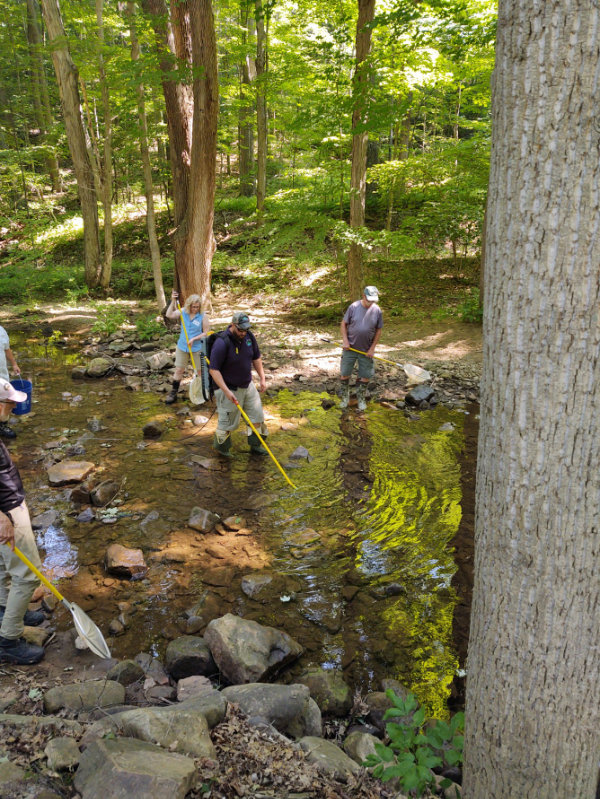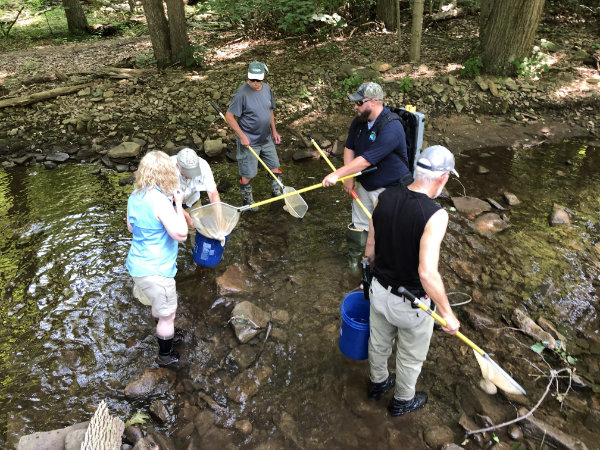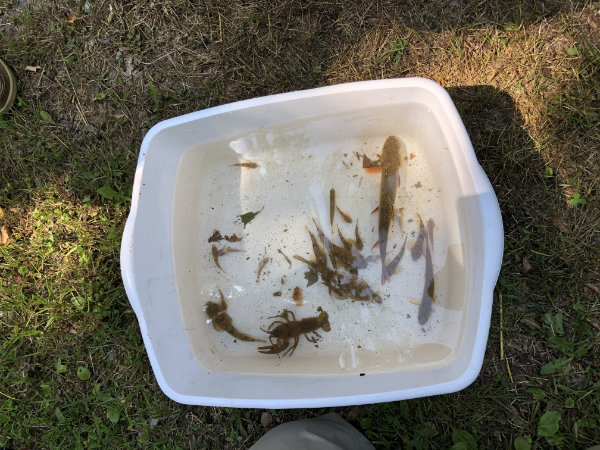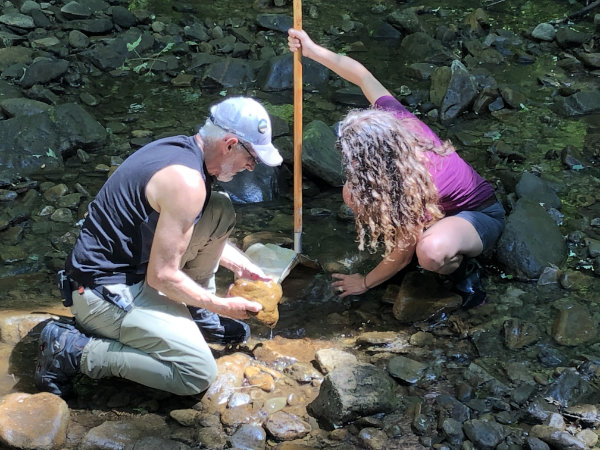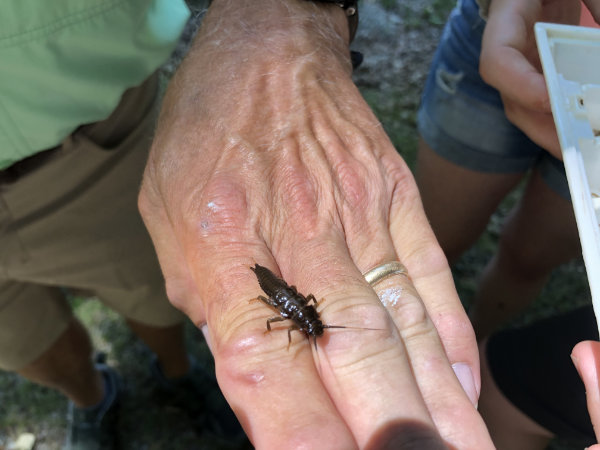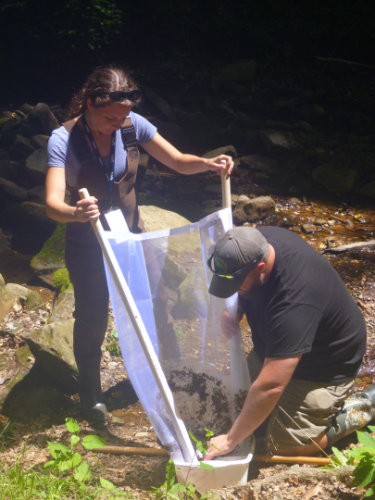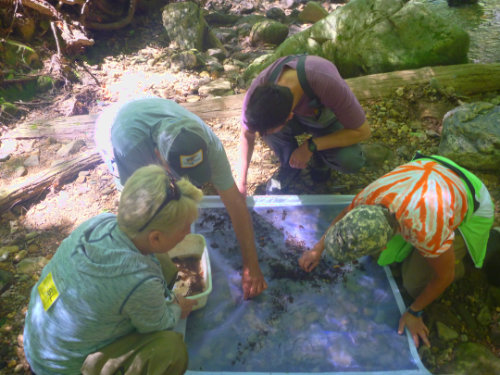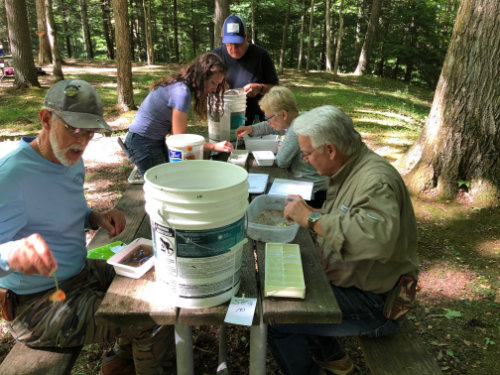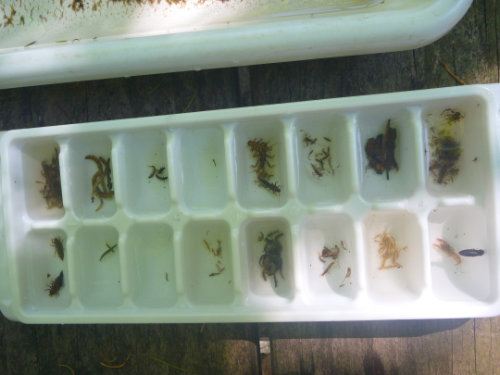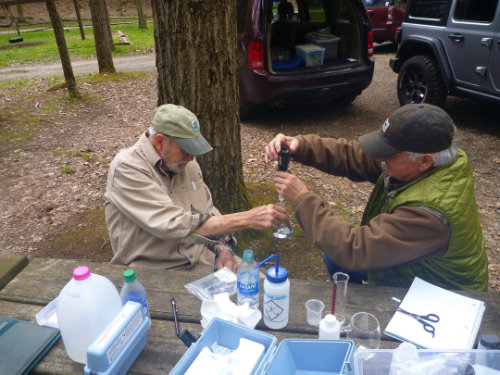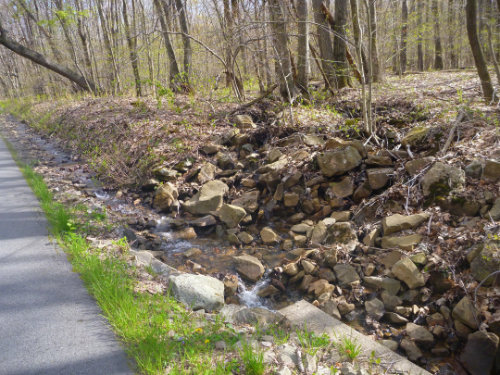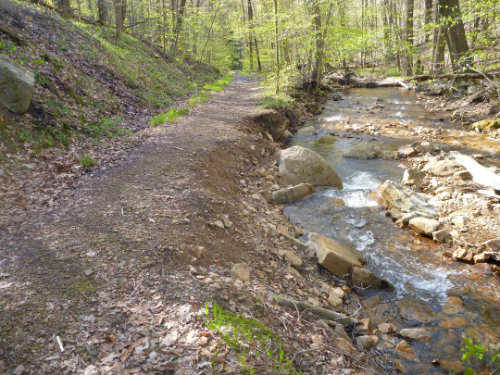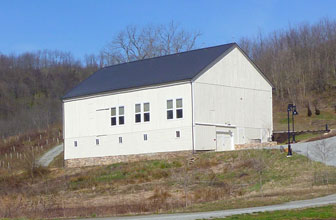Category: Linn Run
Linn Run Conservation Plan Released
Forbes Trail Chapter of Trout Unlimited debuted their final Linn Run study results at a public meeting on March 30, 2023, at the Powdermill Nature Reserve. Thirty-five guests were present to learn about the overall health of Linn Run watershed and what threats to the stream need to be addressed.
The study began in April of 2021 and was funded with a grant from the Foundation for Pennsylvania Watersheds, a grant-making foundation that invests in efforts to protect healthy, natural streams around the state. The study was a “partnership” effort involving state and local agencies and nonprofit organizations, each bringing unique expertise to the table. Nearly fifty volunteers, including TU members, citizen scientists and professional chemists and entomologists worked on the project for nearly two years.
The specific studies looked at the water quality including potential pollutants such as E. coli, iron oxide, road salt and aluminum which can harm all aquatic life. Extensive sampling done for macroinvertebrates (trout bugs), showed that the main stem and the major tributaries all had a healthy variety and number of bugs.
Teams of volunteers conducted habitat assessments looking at every inch of the stream and tributaries from the first raindrop on Laurel Mountain to where Linn Run passes under the Rt. 381 bridge in Rector. Bank erosion from flash floods, hiking trail washouts, log jams and barriers restricting fish movement were some of the problems discovered. The Hemlock Woolly Adelgid (HWA), a tiny insect that infects the needles of hemlock trees, has been documented and could threaten the canopy over nursery waters.
A limestone treatment system installed on the largest tributary, Rock Run, in 2005 has proven to be effective at raising both the pH and alkalinity of the tributary to where it now supports wild trout reproduction. A similar treatment system might be considered for the headwaters of Linn Run.
The Coldwater Conservation Plan is part of a “process”. The next step will be for TU to meet with partners such as the State Park and Forbes State Forest officials to determine what remediation efforts DCNR might be able to work into their budgets and maintenance plans. Then, decide if grants and more manpower might be needed. Some activities such as clearing log jams after severe floods and monitoring for E. coli, the HWA and gill lice is expected to be an ongoing exercise by the partners.
Overall, Linn Run is a relatively healthy, but somewhat fragile, high gradient mountain stream. It and the surrounding park and forest attract well over 100,000 visitors each year. Linn Run is the “crown jewel” of the watershed and the Partners are committed to Conserving, protecting and restoring it using whatever resources are needed.
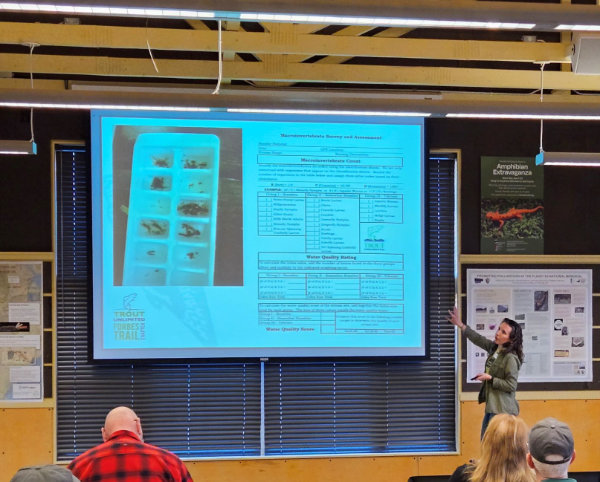
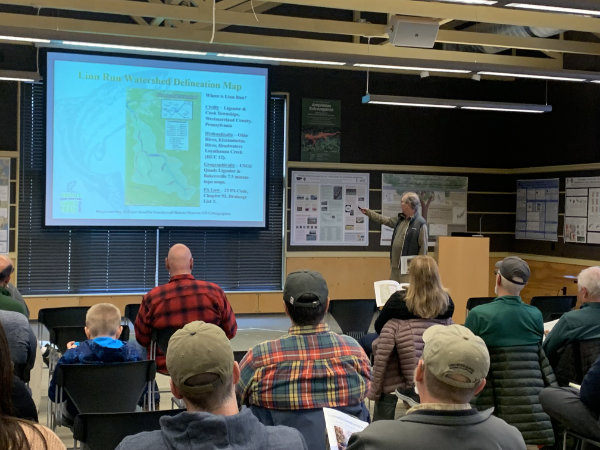
FTTU Volunteers Help Treat Linn Run Hemlocks for Woolly Adelgid
Forbes Trail Trout Unlimited volunteers assisted DCNR staff treat trees in Linn Run State Park for the invasive and destructive insect, Hemlock Woolly Adelgid (HWA). The treatment was conducted on October 20 on trees near the stream. This is the second year DCNR has called on Ron Miller and his crew from Forbes Trail for assistance. Trees were treated with an insecticide, mixed by DCNR staff, and injected around the base of the tree by volunteers Denny Hess, Ron Miller, Larry Myers and Bill Somogyi. The systemic treatment is absorbed by the roots and travels through the tree to the needles being attacked by the bugs. Another option used by DCNR in other areas is a predator beetle called Laricobius nigrinus (Ln). The chemical treatment works short term and is effective for up to 5 years or more. The beetles take longer to develop an effective population and is more of a long term solution. HWA is a major concern to TU because it threatens the canopy that keeps the headwaters cool where wild trout reproduce.
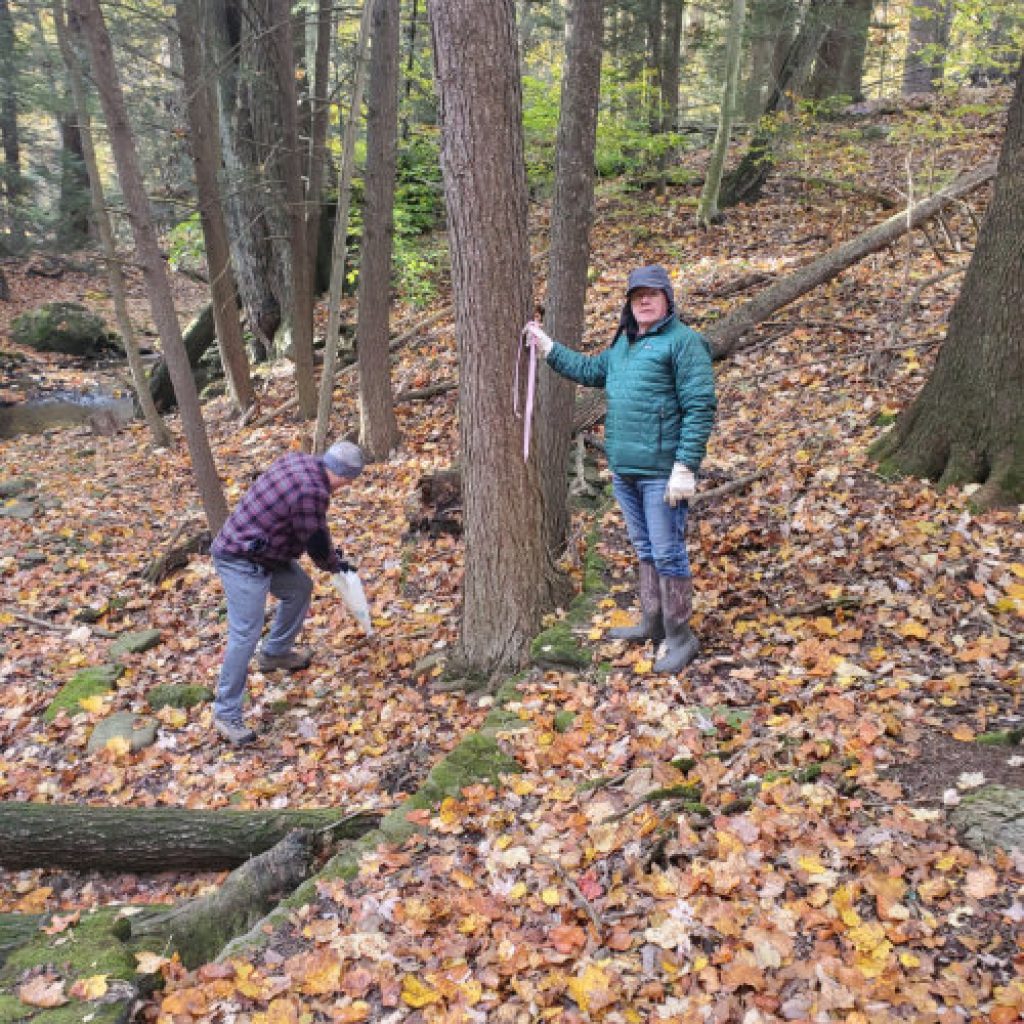
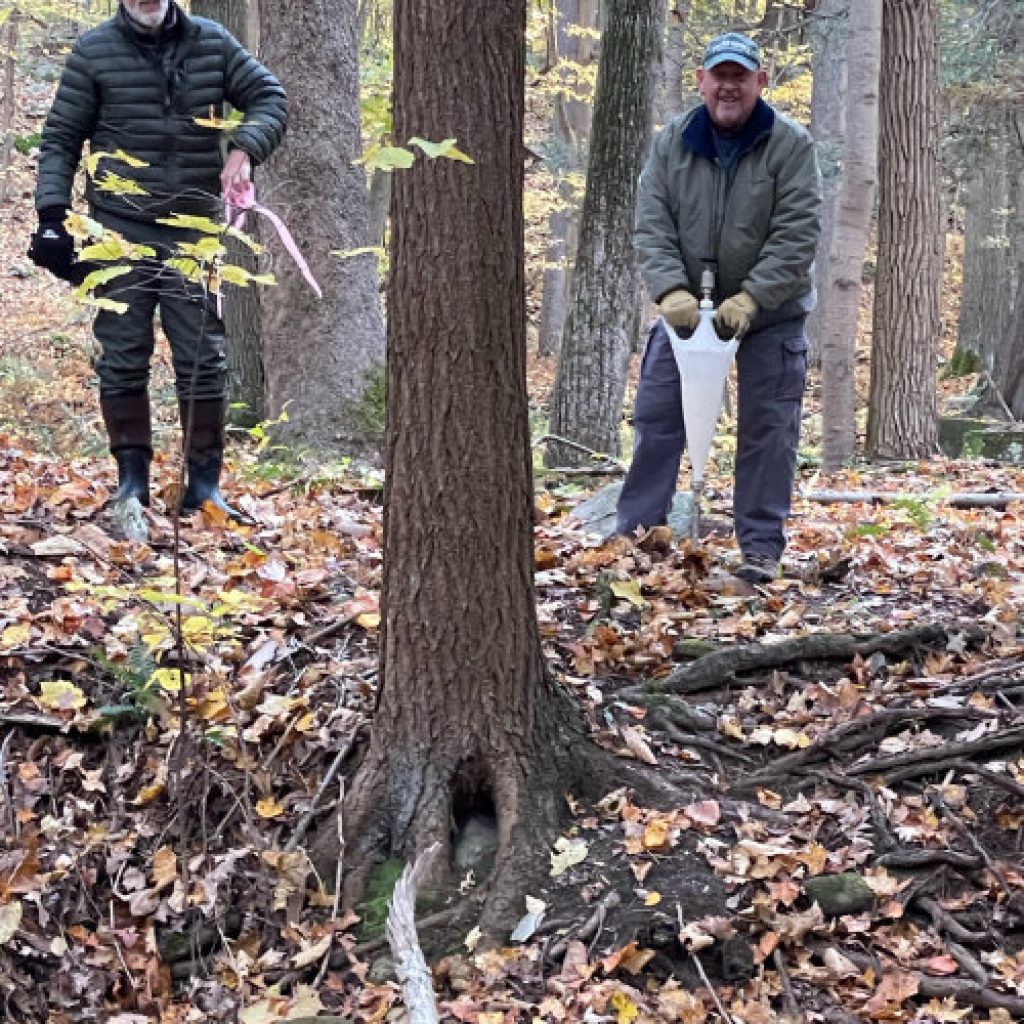
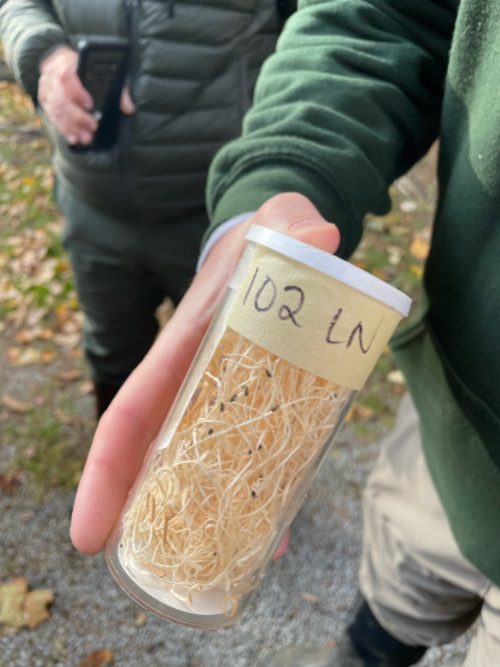
Electro-Fishing Survey in Linn Run Watershed
On Thursday, June 9, 2022 a team of Forbes Trail TU members and Josh Penatzer from the Loyalhanna Watershed Association completed a fish study on Linn Run. The sampling was part of the Coldwater Conservation Plan being developed by FTTU for Linn Run and its tributaries. The crew netted wild brook trout, stocked rainbows, sculpins, blacknose dace and an abundance of stone flies. Josh, who is licensed to use the equipment and conduct the survey, used battery operated probes to stun the fish enough that volunteers could capture them in nets. Once identified and measured, they we all released back into the stream unharmed. The crew sample four sites on Linn Run, including the headwaters, and one location on Rock Run, a major tributary. The detailed results will be made available in the final CCP report later this year.
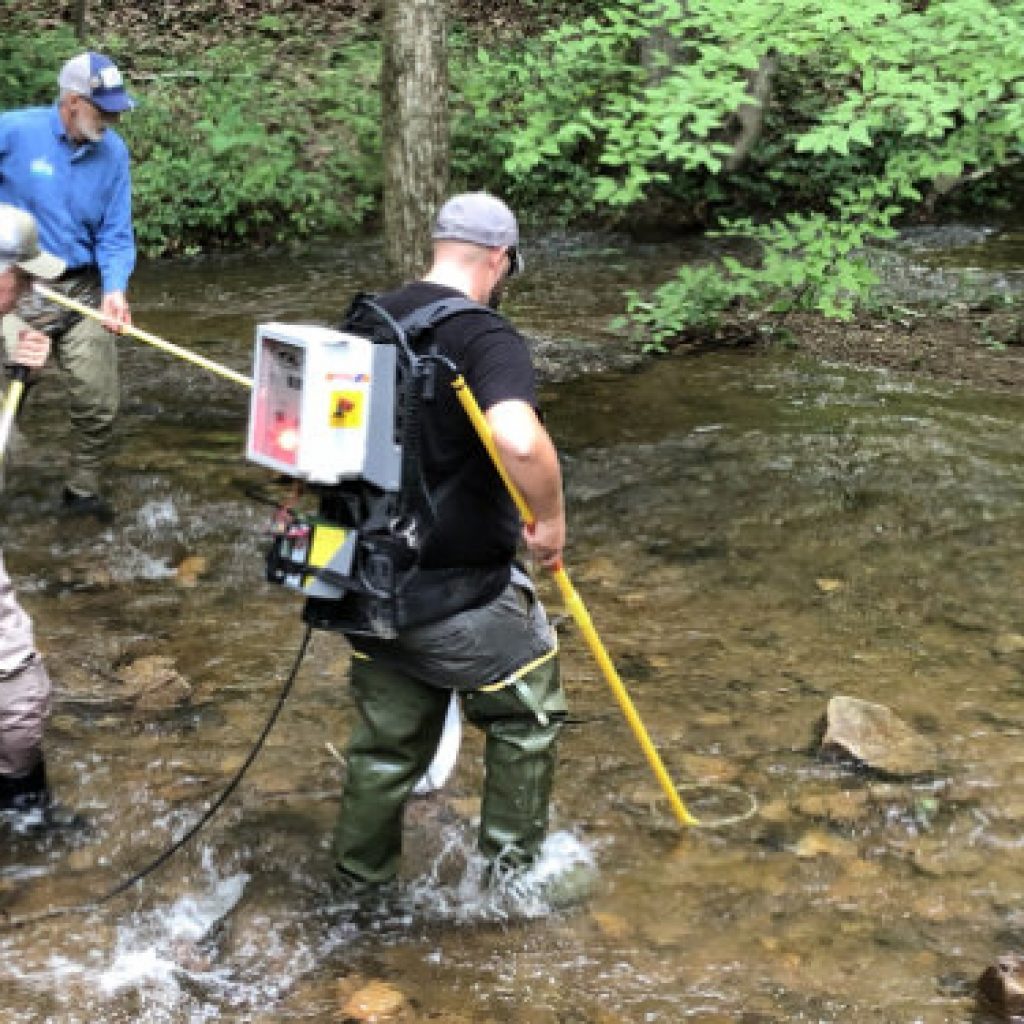
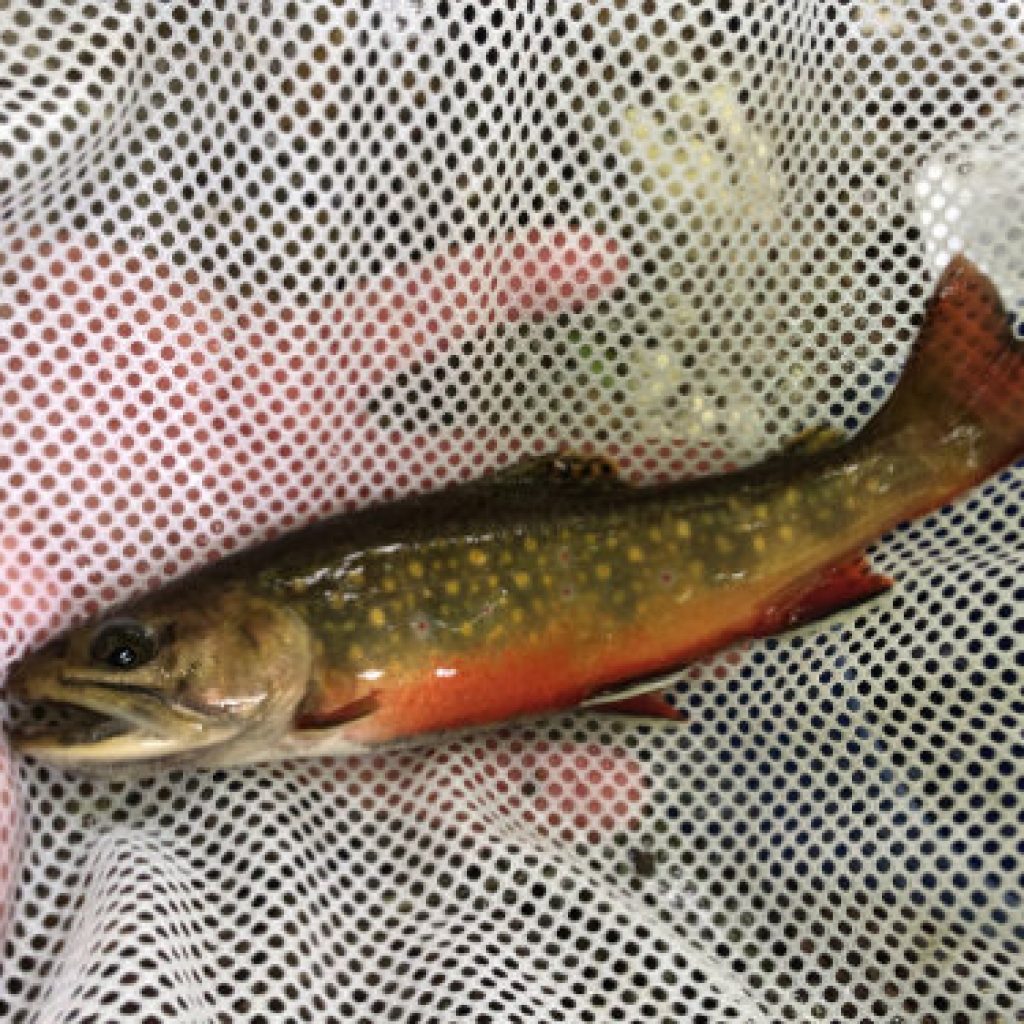
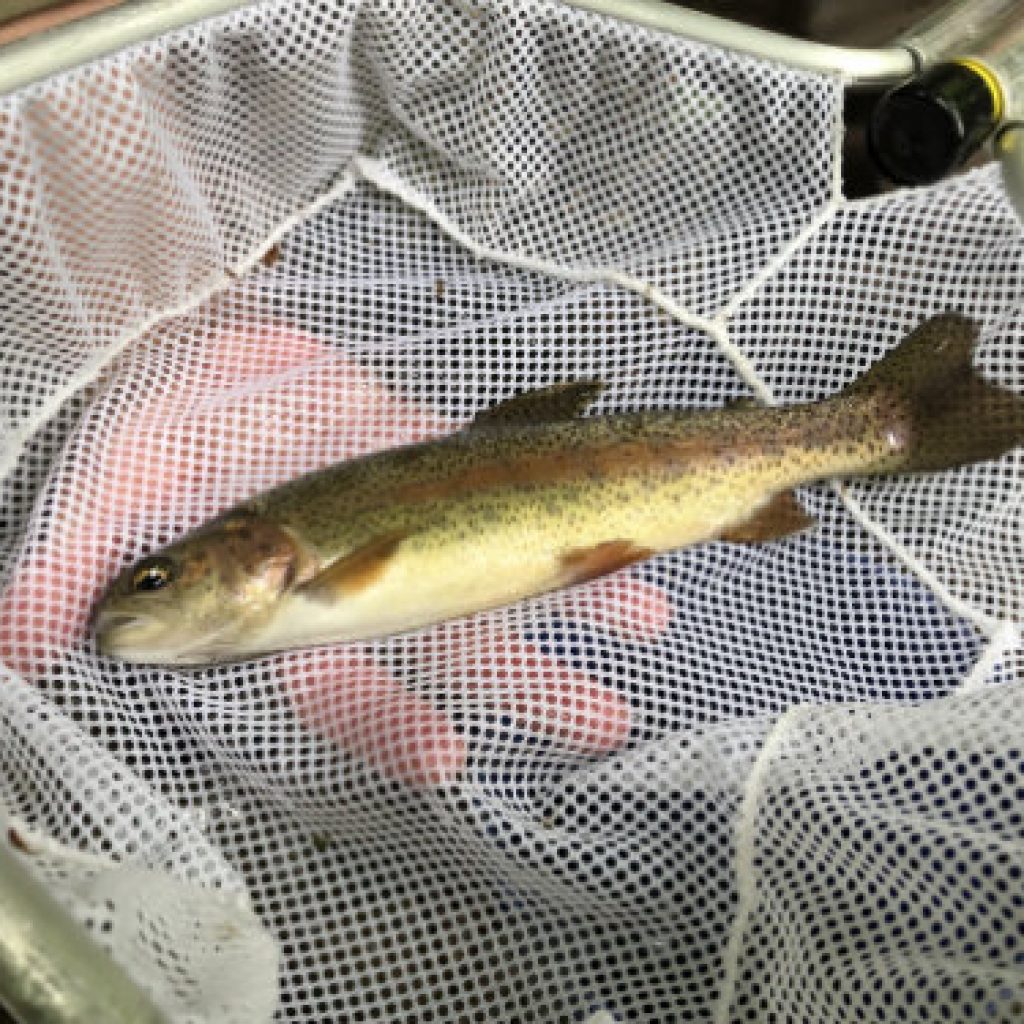
Linn Run Cold Water Conservation Plan Update
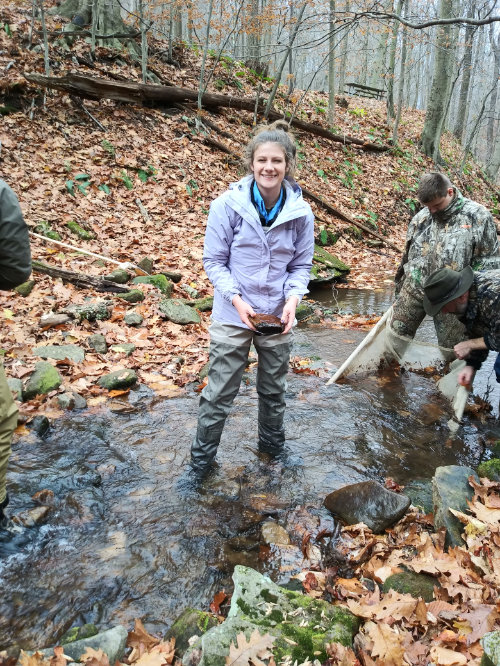
Forbes Trail members and local volunteers wrapped up three days of water quality sampling and macroinvertebrate (trout bugs) studies on Linn Run and its tributaries in mid-November. They enjoyed beautiful weather for two of the days. But, the last day of macro, they had to deal with rain, falling temperatures and working under a dark pavilion to sort and identify the bugs. All in all, they collected a large quantity and wide assortment of bugs and the water quality in the stream is looking good.
Andrea Kautz from Powdermill Nature Reserve and Josh Penatzer from Loyalhanna Watershed Association were the bug experts assisting volunteers with sorting and making correct identifications. Strict protocols have to be followed for collecting the bugs from the stream, including the length of stream sampled, how long to kick the stream rocks and debris, and specific mesh nets to be used. The sorting and identification is a very tedious and eye-straining activity. Many of the bugs must be picked from leaf packs with tweezers.
Water quality samples were first analyzed stream-side by TU members for a number of parameters including pH, alkalinity and dissolved oxygen. Duplicate samples are being analyzed at St. Vincent College for additional parameters using a Microwave Plasma Atomic Emission Spectrophotometer. Analyses there include nitrates, phosphates and metals. Collectively the results will tell the overall health of the stream and its ability to support wild trout.
We thank all of the TU members and volunteers who gave of their time and talents to complete this portion of the study. We’ve had several volunteers from the PA Master Naturalist program offer their skills and expertise over the past year. We offer a special thank you to Elizabeth Bruner who is a 4-H and TU member and homeschooled senior from Blairsville, and Luke Sanner, 4-H member and sophomore at Hempfield High School for their participation. We are pleased to see the younger generation taking such an interest in coldwater conservation projects.
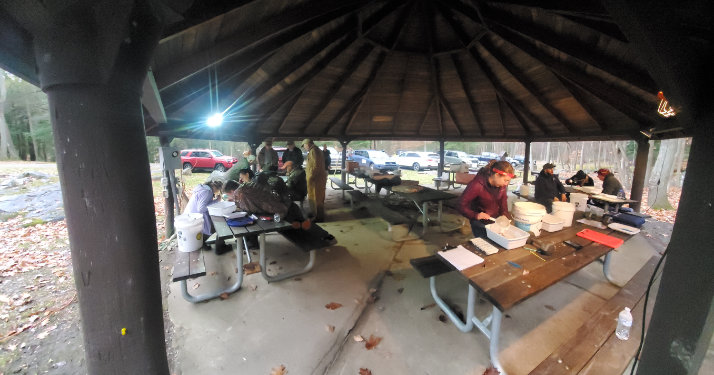

Woolly Adelgid Educational Video
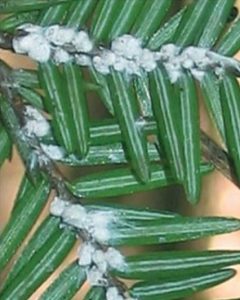
The Woolly Adelgid is an invasive insect pest that threatens and can kill our state tree, the hemlock. Hemlock trees go hand-in-hand with brook trout streams in Pennsylvania.
FTTU’s Ron Miller has put together an excellent video that explains it all and what’s being done to save our hemlocks locally at Linn Run State Park.
Click HERE to see the video.
TU Helps Treat Hemlocks for Invasive Insects
Volunteers from Forbes Trail responded to a request for assistance from Linn Run State Park Manager, Corey Snyder, to treat hemlock trees for an invasive insect. The hemlock woolly adelgid (HWA) has been devastating hemlocks forests in the eastern U.S. for several decades. Once they get a foothold, they spread rapidly and within just a few years, a stand of 200-hundred-year-old hemlocks are dead. The insect, believed to have arrived here in the New England and Mid-Atlantic states from Asia around 1920, is spreading quickly through Pennsylvania threatening our state tree.
Of particular concern to FTTU is the effect it could have on our streams. The canopy of hemlocks along Linn Run and its tributaries could be wiped out, allowing the sun to penetrate and warm the stream. Linn Run is classified as a High Quality Coldwater Trout Stream by the PA Fish and Boat Commission. That classification, and of course the fishery and supporting aquatic insect population, are at risk.
One means of control is with predator beetles. But it would take years to establish a population that could naturally control the HWA. On October 14, FTTU volunteers assisted park staff in treating 9,000 inches (measured diameters) of hemlock trees by injecting the insecticide Xytect in the ground at the base of the tree to be absorbed by the root system. Foresters from the Bureau of State Forests measured the diameter of the hemlocks to determine the appropriate dose, then had volunteers inject the chemical into the ground around the base of the trees.
Volunteers were trained on site and told how to protect themselves while using the chemicals. The chemical works systemically by the tree absorbing it through its root system up to the branches and needles where the HWA sucks out the sap. This is a very expensive and labor-intensive operation. But our state tree and historic stands of hemlocks are at stake. Coupled with the impact of warming weather from climate change, our coldwater streams are at high risk. FTTU wants to help do its part. We may be calling for more volunteers in 2022. Corey Snyder expressed the Park’s gratitude for TU’s quick response to this matter. “We couldn’t have completed it this year without your group’s help!”
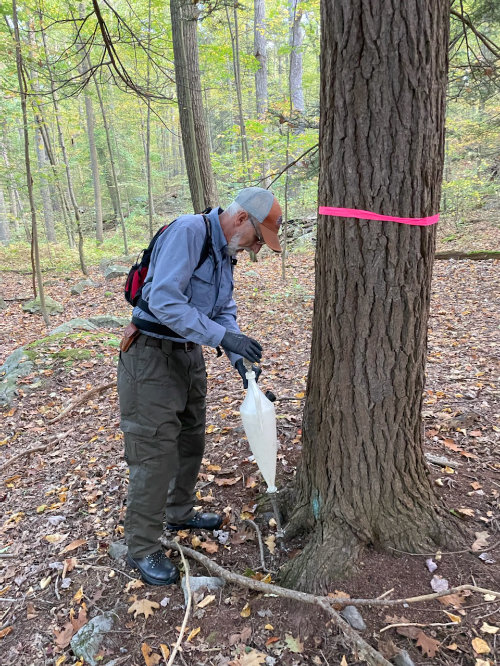
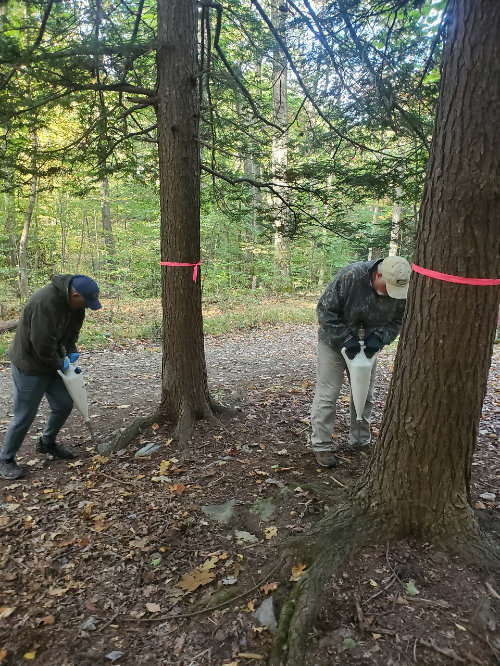
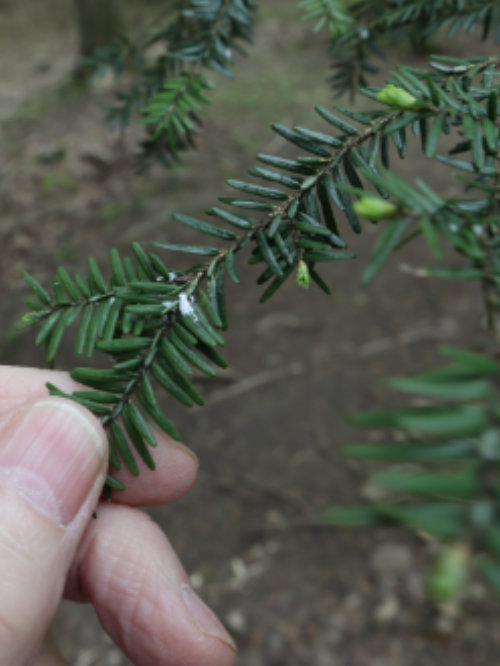
Volunteer Appreciation and Media Day Held at Linn Run State Park
FTTU held a volunteer appreciation day on Wednesday, June 29, on Linn Run and invited the local media to attend. A picnic lunch was the chapter’s way of thanking everyone who volunteered their time and services for the study. Demonstrations of electro-shocking and macroinvertebrate collection were conducted. Josh Penatzer, Project Manager for Loyalhanna Watershed Association donned the battery pack and electrodes and probed the waters while volunteers followed with nets. The sampling was abbreviated because the water was low and they didn’t want to stress the wild brook trout. More extensive electro-shocking will be conducted in the spring during higher water flows and fish will be checked for gill lice then released unharmed.
Andrea Kautz, Research Entomologist for Powdermill Nature Reserve instructed volunteers on how to use nets to collect trout bugs. Alongside the stream, she coached the volunteers how to sort and identify the bugs which are indicators of water quality. They captured an assortment of mayflies, caddis flies and stoneflies in a matter of minutes. Both Andrea and Josh supervised the volunteers on June 16th when they sampled 12 sections of Linn Run including the major tributaries.
FTTU received a grant through the Foundation For Pennsylvania Watersheds to do a comprehensive study of the Linn Run Watershed with the end result being a Cold Water Conservation Plan identifying problem areas that can be addressed to improve conditions for the native brook trout inhabiting the watershed.
With assistance from our partners at The Loyalhanna Watershed Association, DCNR/Linn Run State Park, The Western Pennsylvania Conservancy, Powdermill Nature Reserve, Westmoreland County Conservation District, PA Fish and Boat Commission, The Ligonier Valley School District and our own citizen scientist volunteers, we have so far completed a visual habitat assessment, a macroinvertebrate survey and a water quality analysis. Look for the conservation plan to come out in 2022.
Linn Run Conservation Plan Work Continues with Macro Study
On Wednesday, June 16, FTTU volunteers gathered at the Grove Run Picnic area in Linn Run State Park to do a comprehensive aquatic macroinvertebrate collection and study of Linn Run and its tributaries. Andrea Kautz, Research Entomologist at the Powdermill Nature Reserve, and Josh Penatzer, Project Manager with the Loyalhanna Watershed Association, were the professionals who supervised the study. Previously, Andrea conducted a macro identification training session for volunteers via zoom, and both Andrea and Josh demonstrated the use of kick nets, explained the collection protocol, and oversaw the identification, sorting and scoring process on site. FTTU members with previous experience in macro collection led teams that carried out the kick net collection at 11 different sites within the watershed. Each site had at least 200 organisms captured. The samples were collected in buckets and brought back to the Grove Run Picnic Area where they were counted and sorted to the Genus level and then returned to the stream. All this work was carried out between 1:00 pm and 7:00 pm thanks to the great response we had from volunteers and Andrea and Josh’s guidance.
The numbers and types of macroinvertebrates inhabiting a stream are great indicators of stream health particularly the “high quality” Genus’s of mayflies, stoneflies and caddis flies.
The final report for the Linn Run Coldwater Conservation Plan will be produced in about one year. The study is to determine the overall health of Linn Run and the fishery. Next step, based on the information collected, is to determine if there are potential remediation projects we can undertake that might improve stream health and trout habitat.
Linn Run Conservation Plan Underway
FTTU has been wanting to do a comprehensive study of the Linn Run watershed for a long time and finally, it’s happening in 2021. President Larry Myers has assembled a team with FTTU and local conservation organizations including the Western Pennsylvania Conservancy, the Westmoreland County Conservation District, the Loyalhanna Watershed Association, the Powdermill Nature Reserve, DCNR – Linn Run State Park and FTTU citizen scientists and local volunteers to accomplish the work. The first step was to do a visual habitat assessment of the watershed which involved walking the entire length of Linn Run and its tributaries. FTTU and community volunteers were assigned “beats” and put boots-on-the-ground looking for impairments and scoring their sections in various categories including sediment deposition, channel flow, embeddedness, riparian vegetative cover, riffle-run-pool frequency and bank stability. The teams took detailed notes, photos and GPS coordinates.
Water quality was next. Samples were collected at various locations around the watershed and were tested for pH, alkalinity, dissolved oxygen and total dissolved solids at our on-site lab at the Grove Run Picnic Area on May 12. Other samples were taken in key locations for professional testing for nitrates, phosphates, acidity, aluminum and turbidity.
Up next will be a macroinvertebrate study and an electro-fishing study. Locations for these activities is to be determined.
Many thanks to our partners, Greg Schaetzle of the Western Pennsylvania Conservancy conducted the habitat assessment training, Andrea Kautz of Powdermill will do the macro identification training and Josh Penatzer will handle the electro-fishing study.
The project is funded by a grant from The Foundation for PA Watersheds.
The results will be compiled into a Conservation Plan which will make it easier for us to acquire grants for future stream improvement projects.
FTTU Assists with Leaf Pack Study
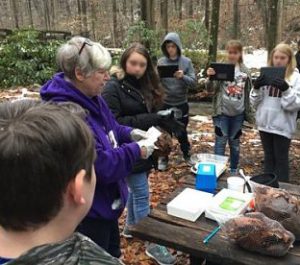
Volunteers from FTTU were on hand for an educational day on the stream with local junior high school students. Becky Bell, a retired biology teacher with the group Graceful Aging, conducted the session at the Adams Falls area of Linn Run State Park. The kids learned about macroinvertebrates and how to conduct a leaf pack study. Leaves from various species of trees surrounding the stream are placed in mesh bags and anchored in the stream. Macroinvertebrates, which feed on leaf litter, take up residence in the leaf packs. After a period of 3-4 weeks, the students will collect the bags and analyze their contents. We are interested in seeing if the summer flash floods which scoured Linn Run’s stream bed, had an effect on the macro populations. For more info on leaf packs see https://www.youtube.com/watch?v=zCeCj5qu4K4

